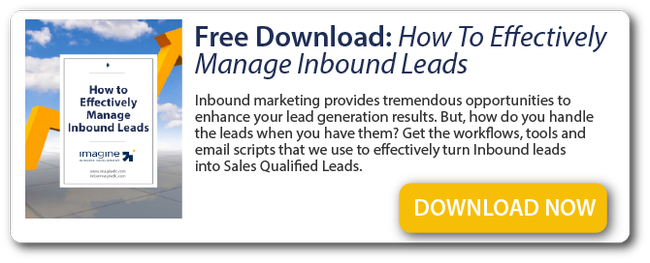
In the sales and marketing world, there are few issues that are getting more attention than the issues surrounding lead management and follow up. In my experience, clarity around lead management, qualification and response times are the crucial linchpin to align sales and marketing efforts.
It’s a rather scary statistic, but according to a study most recently done for Harvard Business Review, 71% of qualified leads are never followed up with. What’s more is, of the leads that are followed up on, they’re only touched an average of 1.3 times. This represents tremendous opportunity costs not only in revenue, but in the customer/prospect experience as well.
This is why creating a clear service level agreement (SLA) is important. An effective Lead Management and Response SLA lays out how leads should be treated, when they should be followed up with, how often they should be followed up with and how the sales and marketing sides of the organization will be held accountable in the process.
While there is a tremendous amount of research on how to respond to inbound leads, developing effective protocols requires more than just determining the source of a lead. What’s important is determining the quality and the context of the lead you have generated.
The Four Components of Lead Classification
We’ve identified four components that must be factored in when developing lead management protocols:
1) Type of Product/Service
Is your offering one that fills an already existing need, with an existing line item; or, are you selling something to solve a problem that isn’t being managed, with no existing line item? If you’re selling the former, you’re response management is going to need to be on the faster side of what I explain below.
2) Source
Where did the lead come from? The simplest designation via inbound or offline efforts. Inbound leads typically need much faster response that offline leads do. However, it’s not always that simple. There are offline sources that need quick responses, but not every inbound lead should be responded to immediately.
3) Company Quality
An important rule to remember when qualifying leads is to always be qualifying the company, not the contact. Whether it’s someone who downloaded a white paper or checklist from your website, gave you a card at a trade show or called in to your main number, you want to be paying attention to the company when assessing the strength of a lead. The higher the lead quality the faster you’ll want to respond.
4) The Buyer’s Journey
You must consider where the prospect finds themselves in their buying journey. While responding within five minutes of a download is ideal at the bottom of the funnel, it can turn people off when they’re at the top. To get a feel of where your prospect most likely is, consider:
- Which of your buyer personas do they represent?
- What offer did they download (or how else was the lead created)?
- What other actions have they had with your company and website?
The lower the prospect is in the funnel (the closer they are to their decision stage), the faster you are going to want to respond.
Lead Scoring vs. Lead Triage
With your lead classification criteria clear, next you’ll want to decide whether you’ll take lead scoring or (what I like to call) a lead triage approach. While lead scoring is a hot topic, with the siren song of certainty, I’ve found that very few companies are in a position where they should actually focus on lead scoring. Lead scoring works when:
- There is certainty about what actions and attributes cause a prospect to be more likely to buy, and
- You’re being overwhelmed with more leads than your sales team can manage. If you’ve got capacity to respond to more leads, lead scoring is relatively useless.
Lead triage is a simple (and at least partially manual) process of reviewing each lead to categorize it within the context of your lead management SLA. The job is to simply classify each lead as qualified, not-qualified or not enough information to determine.
For qualified leads (QLs) the vast majority of companies will do fine designating each QL as low, moderate or high quality. That designation should trigger corresponding actions within your SLA. If you feel the need for a more nuanced approach you can add a bottom/not-bottom category to each designation.
Effectively Responding to Leads
The first rule of lead response is “respond.” Keep things simple, as the statistic at the beginning of this post highlight, merely responding to leads puts you in the top quartile of organizations.
Timing of Response
For a lead generated online, waiting just five minutes will reduce the likelihood of contact by 10x factor. Now, as I shared in the classification section, I’m not an advocate that every online lead be contacted instantly. First off, few companies have the resources to consistently respond in such a manner, and secondly the context of your prospect often make it unnecessary.
I share this statistic to highlight that time is of the essence. For companies with a lead response system in place, the average response time is 46 hours, 53 minutes – almost two days! That is simply too long for the average initial response.
Frequency of Response
When developing your lead response process, you want to address not only the time that a qualified lead should be responded to, but the frequency as well.
As I shared above, the typical lead is touched by a salesperson on average only 1.3 times. Increasing the number of touches to six increases the likelihood of making a contact by 70%.
When crafting your response protocols, you’ll want to integrate voice mail and email. Highly qualified leads should get at least six outreaches over a sustained period of time.
The Importance of Nurturing
As a part of your lead management process, you’re going to want to designate whether a lead is being actively or passively managed. If you fail to connect with your prospect within the time prescribed in your SLA, and even if you connect and no sales action is initiated, you’ll want to make sure you have a defined nurturing process in place to position yourself strongly in the future.
![]()



